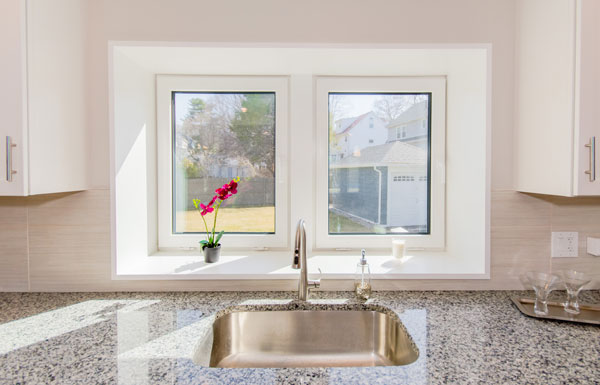The winter of 2014-2015 was Boston’s snowiest in more than a century. With snow totals topping 108 inches, homes across the region turned into ice palaces, leaving owners with leaky roofs, destroyed walls, and ruined furniture. The area’s older properties fared worst of all. Yet one home, built in 1927, endured the onslaught without collecting a single icicle. Inside, the windows were warm to the touch, even as sub-zero winds howled outside.
That’s because the house, a two-story brick Tudor, had recently been gutted and the walls, windows, and doors overhauled to achieve nearly net-zero energy usage. The deep energy retrofit aimed to preserve its 1920s character while outfitting it with 21st-century efficiency.

REHAU’S GENEO windows are triple-glazed and meet—even exceed—stringent Passive House standards. [PHOTO: COURTESY OF REHAU]
As in any project, the team considered a number of different window options, weighing the usual constraints. “Obviously cost is one of the biggest ones,” Butler says, “but it’s not the biggest one, because we’re in the context of a deep energy retrofit, where performance is also weighted very strongly.” REHAU quickly rose to the top of the heap. The German company has been designing uPVC windows for more than 60 years, earning accolades along the way for their efficiency, durability, and ease of maintenance.

Good Energy Construction and the project architect, SA2 Studios, opted for REHAU’s GENEO windows, a fully reinforced polymer system that provides superior strength without relying on steel. The triple-glazed windows meet—and even exceed—stringent Passive House standards. As a blend, the fiber composite has the benefits of both PVC and fiberglass. It’s similar, in fact, to the components used in aircraft and Formula One racecars.
Instead of importing from Germany, the renovation team found a company, WASCO Windows, that fabricates the windows stateside—vastly improving the turnaround time, Butler says. WASCO Windows has been building REHAU windows in its Wisconsin factory since 1989 and GENEO windows since 1992. WASCO Engineering director David Paulus gained a deep appreciation for the brand during the years he spent teaching at the Technical University of Berlin. When he returned home to the family business, which his father had run since 1983, Paulus modernized the factory with German equipment. The REHAU system created a whole new market for WASCO—growing the staff to 13 employees that now produce about 500 GENEO windows annually.

The windows allowed the team to achieve both aesthetic and environmental goals, with the retrofit exceeding the building code energy requirements. PHOTO: COURTESY OF REHAU
By building German windows, on German machines, WASCO is able to give all the quality of a premium window that you would buy in Europe, along with the convenience of stateside fabrication, Paulus says. “That allows us to deliver faster, and it also allows us to deliver far better technical support,” he says. “If something goes wrong on a job site, we can give technical advice one time zone out, instead of seven time zones out. And because we build these ourselves, we know what can go wrong—and how to fix stuff.”
 For architect Sayo Okada of SA2 Studios, that proximity was invaluable. Construction, after all, is all about expecting the unexpected. When a window breaks or is damaged on a job site, for example, shipping a new window from Europe simply takes too much time—time that can’t be sacrificed on a tight schedule.
For architect Sayo Okada of SA2 Studios, that proximity was invaluable. Construction, after all, is all about expecting the unexpected. When a window breaks or is damaged on a job site, for example, shipping a new window from Europe simply takes too much time—time that can’t be sacrificed on a tight schedule.
The GENEO windows feature a “tilt-turn” system, the predominant window option in Europe. By turning the handle 180 degrees, the homeowner can tilt the windows at the top, allowing in natural ventilation without letting in rain. Turn it 90 degrees, and the window swings inward for easy cleaning and an intuitive means of egress in case of emergency.

That feature contributes to the windows’ “wow factor,” Butler says. Because they’re so different from a typical American fixture, visitors breeze past the kitchen—itself a showstopper—to closely examine them. “People are just drawn magnetically to the windows,” he says.
For Butler, the project was a showstopper, both aesthetically and environmentally. “From a high-level view, the deep energy retrofit basically exceeds the building code energy requirements by two to three times,” he says. That’s compared to the stringent standards for a new build. “So that’s pretty cool, because you’re taking an older home, that probably was two to three times worse than code, and making it the opposite when you’re done.”
Download a PDF of this story here and see more gb&d coverage here.
Connect with REHAU: Website | Facebook | Twitter



